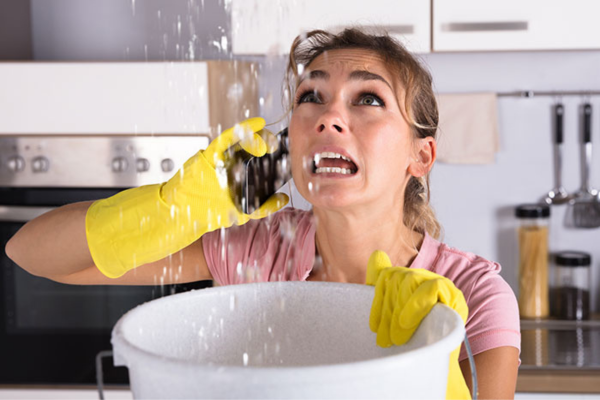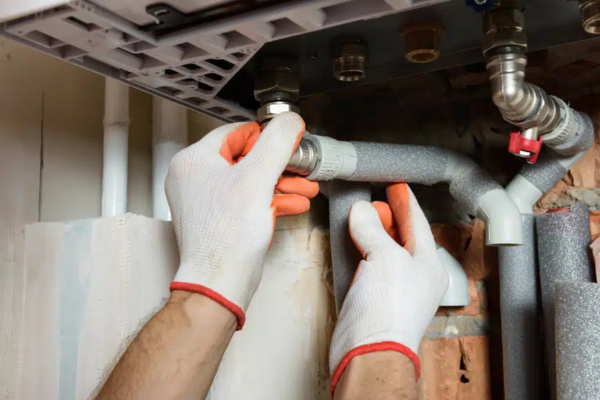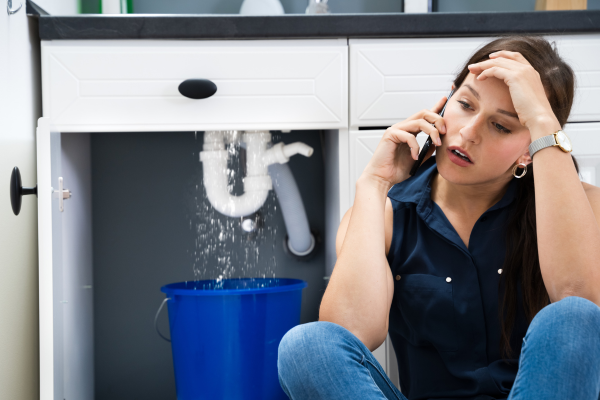It’s very rarely as disturbing as it gets to wake up and find your house deluged with water from a burst pipe. Of course, the immediate concern is to turn off the water supply. The next thought which immediately comes after this would be: Does insurance cover burst pipes? For many homeowners, it is never really known when a pipe actually bursts if their insurance policy will help overcome the damage or leave them with a substantial bill for repair.
Understanding what a homeowners’ insurance policy can cover, especially about burst pipes, means prior knowledge. That is where this guide comes in-to discuss the details of whether insurance covers burst pipes, what situations are usually covered, and what exclusions to check for. By the end, you will know exactly what steps to take if you ever face a burst pipe in your home.
Water damage and freezing are among the most common causes of claims for home insurance, accounting for about 29 percent (III, 2024).
What is a Burst Pipe?

A pipe is said to have burst when, within the pipe, the pressure exceeds its limits and causes the pipe to burst. This might result in sudden explosion that could bring massive destruction of things, if not dealt with immediately, owing to the presence of water. The pipes rupture due to several reasons, ranging from frozen temperatures to internal corrosion.
Reasons for Burst Pipes :
- Freezing Temperatures: Freezing water inside the pipes will expand and increase the pressure on the pipe, which can cause a pipe burst.
- Aging or Corroded Pipe: Sometimes, when pipes get older, they weaken due to corrosion or wear and tear and become more vulnerable to bursting. High Water
- Pressure: Too much pressure on the plumbing system will stress the pipes until they finally rupture.
- Blockages and Clogs: Building pressure from clogged pipes can result in pipes bursting, especially in serious blockages.
Understanding these causes will both prevent bursting pipes, as well as give some insight when your homeowners’ insurance might come in to help out.
Homeowners Insurance and Burst Pipes Coverage
Does Insurance Cover Burst Pipes?
Whenever the question is put across, “does insurance cover burst pipes,” the immediate answer would be yes but with caveats. While a number of homeowners insurance policy covers damage due to a burst pipe, the extent of coverage would depend upon the policy specifics and the cause of bursting the pipe.
Types of Policies That Cover Burst Pipes:
Most homeowners have an HO-3 policy, which covers sudden and accidental damage. Burst pipes are covered under this policy if they burst due to a sudden and unexpected occurrence, such as freezing weather. This, of course, is contingent upon the homeowner making reasonable care to maintain the property.
Scenarios Where Burst Pipes Are Covered By Insurance
The following instances concerning burst pipes are usually covered by insurance:
- Accidental Damage: If the pipe bursts because of a sudden freeze or build-up in pressure under such circumstances, the repairs are normally covered under homeowners’ insurance.
- Water Damages to Personal Property: If, by any reason, water from the burst pipe damages your belongings, such as furniture, electronics, or clothes, then your insurance policy will cover costs associated with their replacement or repair.
- Structural Damage Repairs: The destruction of floors, ceilings, or walls from water due to a burst pipe is usually covered under insurance.
- Weather-related damage: The insurance may cover the case where there are burst pipes due to heavy rain, heavy snowfall, or ice build-up.
- Plumbing Issues: If the pipe bursts due to frozen or faulty plumbing, it is normally covered. Also, sudden and accidental overflows from an appliance or fixture.
- Water Damage from Fire Extinguishment: It is in regard to such situations where the pipes have burst or got damaged in case of extinguishing a fire. In that regard, it normally covers both water damages and the repairs related to fire.
- Leaky Roof: If water damage from a leaky roof has contributed to your pipes bursting, then you’re covered under your home insurance, most likely.
- Accidental Overflow: Whether an overflowing toilet or one sink, or an overflow from a washing machine, it often includes coverage from accidental overflows of water damage.
- Mold: Many include mold coverage under coverages that result from covered water damage, such as a burst pipe.
- Vandalism: If your plumbing system has been vandalized, leading to burst pipes, such kinds of damage are usually covered under most policies.
When Burst Pipes Aren’t Covered
While a number of burst pipe situations are covered under homeowners insurance, there are quite a number of instances when coverage will not apply. You need to understand what exclusions your policy has.
- Negligence Exclusions: Homeowners insurance will not cover burst pipes if the damage is due to negligence. Take, for example, failing to heat your home during winter and having a pipe freeze and burst. Under such circumstances, your insurance would have every reason to deny the claim because you have not taken due care. Also, when your pipes burst owing to a gradual problem that you have been remiss in solving, such as corrosion or small leaks, it automatically becomes a maintenance case rather than an incidental one.
- Flooding Exclusions: One of the main misconceptions is what insurance covers in case pipes burst from flooding. If the pipe burst due to flooding or any other natural disaster, standard homeowners insurance will not cover this. You would need to have flood insurance for that, which would cover damage due to flooding, especially in homes located in flood-prone areas.
What do you need to be covered for in the event of burst pipes?
Coverage can be applied under three major kinds of home insurance policies when any damage is caused by bursting pipes. They include:
- Dwelling coverage: Dwelling coverage pays to repair the physical structure of your home. In this case, when pipes burst and the resultant water bursts onto the floors, walls, or other parts that are structural to your home, your dwelling coverage will help pay in the repair of such damages.
- Personal property coverage: It would help to repair or replace belongings, such as furniture, clothes, and electronics, that are destroyed or damaged in a covered event-a burst pipe in this case.
- Loss of use coverage: This coverage helps in the payment of temporary living expenses if you can’t live in your home as a result of an incident that is covered under the policy. The coverage may extend to hotel costs, meals, and other living essentials.
Does homeowners insurance cover water line breaks?
Like burst pipes, homeowners insurance usually covers the breaking of water lines when sudden accidental damage causes it.
Unless specifically added, a water line breaking on your property probably wouldn’t be covered under regular coverage if the cause is:
- Age
- Normal wear and tear,
- Poor installation,
- Repeated ground temperature fluctuations,
- Soil settlement,
- Infestation by insects or rodents or due to tree root invasion.
If a city water main breaks, the break typically would be repaired by the municipality. However, you’re probably responsible for repairing or replacing the section of water main that’s connected to your house. You will have to deal with your local government and your insurance company in such a case to cover the damages from the correct party.
Burst Pipe Repair Costs: How Much Does It Really Cost? Even with Insurance?
Deductibles for Burst Pipe Claims
The first of the costs to insurance claims to repair burst pipes involves the deductibles. The deductible is an amount that you have to pay out-of-pocket before your insurance policy kicks in to cover the rest. Most deductibles run between $500 and $2,500, but that depends on your policy.
For instance, if the cost of damages due to the burst pipe is $10,000 and your deductible is $1,000, then you pay for that $1,000, while the insurance covers the remaining $9,000. That means it is very important that you review your policy to understand what your deductible is ahead of time before something like a burst pipe occurs.
Coverage Limits in Homeowners Insurance for Burst Pipes
Another very important consideration is the coverage limit on your insurance policy. This limit defines the maximum that the insurance policy will pay out for all types of damages. The most significant areas of concern in relation to the coverage limit of the insurance policy include:
- Personal Property: Under this, insurance will cover only up to a specific amount of damage caused by water from a burst pipe to personal property. You have to pay out of pocket for the rest if the cost is more than that amount.
- Structural Damage: Generally, policies provide coverage for structural repairs, but again there can be a limit. It is essential to review the limits of your policy and ensure they are good enough if major repairs become necessary due to substantial water damages to flooring, walls, and ceilings.
Understanding these limits protects you from being blindsided by expenses that exceed your coverage.
Extra Expenses Not Included Under Insurance
Homeowners’ insurance doesn’t cover all the expenses regarding burst pipes. Mentioned below are some other expenses that may not be covered by your policy:
- Wear and Tear: In case there is any bursting of pipes due to long-term wear and tear, rust, or corrosion, these costs may not come under the coverage of your insurance. Insurance covers only sudden, abrupt, and accidental damages and not the gradual loss.
- Maintenance-Related Issues: In case the bursting is because of poor maintenance of your plumbing, such as failing to insulate the pipes during cold weather, the insurance company may not accept the claim.
- Code Upgrades: Sometimes, upgrading to new building codes due to such damages means additional expenses that you may have to incur yourself, as generally, insurance policies do not cover code upgrade expenses.
How to Make a Claim for Burst Pipes
Step-by-Step Guide on Filing an Insurance Claim for Burst Pipes
Each time there is a burst in the pipe at your house, the proper steps toward filing the insurance for coverage should be known. Here’s a step-by-step guide:
- Document the Damage: The moment you realize the pipe has burst, begin to document the damage. Take pictures or videos of any water damage that affects floors, ceilings, walls, and personal property. This documentation is very critical to your insurance claim.
Take action to mitigate any further damages. Stop the water supply to end the flooding, and make temporary repairs, such as using buckets to catch water or placing towels around the affected area, to stop the continuation of damage. This is expected of you by insurance companies to mitigate the claim.
- Call Your Insurance Company: Once the immediate situation is contained, you will want to contact your insurance company. You will want to start the claim and begin the process for submitting necessary documentation such as photos, videos, and descriptions regarding the burst pipe in question.
- Cooperate with the Insurance Adjuster: Immediately, your insurance company will be sending an adjuster to inspect the damages. Be sure to give your full cooperation by allowing them to view the damages and answer all of your questions. The adjuster will determine how much compensation you will be receiving.
- Review Your Policy: After the insurance adjuster makes his assessment of the damages, review your policy to ensure everything that is covered under the policy is being addressed. Check for exclusions and limitations, too, which may impact the payout.
Timeline for Insurance Claims for Burst Pipes
How long the processing of an insurance claim takes varies, based on a number of factors: primarily, the extent of the damage at hand and how promptly the insurer responds to it. In this regard, generally speaking:
- Initial Contact and Documentation: This will take from a few days to about a week, depending on how quickly you file the claim.
- Adjuster Inspection: After the claim is filed, you could expect an adjuster visit in about 1–2 weeks.
- Claim Processing and Payout: After the inspection, another 2–4 weeks may be added for the processing of the claim. An average estimation for the whole process may be around 30–45 days, though larger claims take more time.
This guide would help you through being better prepared for filing your insurance claim and would leave you with a smoother process in the case of dealing with a burst pipe.
Ways to Prevent Burst Pipes and Possibly Avoid Claim Denial

Preventative Measures to Avoid Burst Pipes
Preventing burst pipes saves not only money in repairs for the homeowner but also may avoid claim denials. Insurance companies usually expect homeowners to use reasonable precautions to prevent damage. Here are practical tips that can be used to minimize the possibility of burst pipes:
- Insulating the Pipes: The best ways to prevent pipes from bursting are insulating those that are exposed in colder climates. In areas where a space is not heated, such as basements, attics, and/or garages, these pipes will most definitely freeze and will remain safe if insulated.
- Keeping Heat On: Leave the heat on in your home if you’re away during the cold winter months. Keep your thermostat at least at 55°F so that your house remains warm enough that your pipes don’t freeze. This could be important with vacation homes or homes that may be left unoccupied for a long time.
- Regular plumbing inspections help in finding and addressing the issues while they are still minor.
Plumbers will go through the plumbing to find evidence of wear, corrosion, or any leakage that could predispose pipes to bursting.
Smart Home Technology in the Prevention of Burst Pipes
Technology in smart homes has made the prevention of burst pipes easier now than ever before. Smart water sensors detect early leaks and automatically send notifications to your phone or device in the case of abnormal water activity. Certain systems even automatically shut off your water supply in case of a significant leak, reducing damage from a burst pipe. The truth is that installing this technology in your home will be one proactive step that will also help you avoid claim denials, as it proves responsible home maintenance.
Precautions for Vacant Homes to Prevent Burst Pipes
If you’re planning on leaving your home vacant for some time, here are additional tips you must take on to prevent burst pipes. In the case of a pipe bursting, insurance does not pay for claims if the company establishes it was due to carelessness during your absence. Here are some tips that will help in safeguarding your house when you are away:
- Thermostat Settings: Ensure the thermostat in your home is set to no less than 55°F when nobody is home.
- Turn off Water Supply: When possible, turn off the water supply and drain the pipes so water will not freeze inside the pipes.
- Leave Faucets Dripping: If there is no option to shut off the water supply, make sure you leave faucets slightly dripping so the water will keep flowing, thereby minimizing freezing.
These precautionary steps will help a lot in minimizing the chances of pipe bursts, besides smoothing the way for an insurance claim in case any damage does occur.
Does Insurance Cover Frozen Pipes?
Frozen Pipes and Insurance Coverage
The question to be asked by those who have suffered most from frozen pipes is, “Does insurance cover frozen pipes?” The immediate answer is probably no, if the pipes have not burst. Generally speaking, insurance rarely pays for a damage on a frozen pipe if it remains whole – that is, does not burst. However, when that frozen pipe bursts and causes water damage, this resulting damage is generally covered under your homeowners insurance policy. This cover is provided so long as the homeowner has taken reasonable care to prevent the pipe from freezing in the first instance, such as keeping heat on within the residence or insulating pipes.
Preventative Care to Avoid Frozen Pipes
Prevention of frozen pipes is essential. The winter months, in particular, are a really necessary period of the year when stopping pipes from freezing can really make a difference. Following are more forms of prevention that a home owner may take to maintain your plumbing:
- Let Faucets Drip: When temperatures are extremely cold, letting the faucet drip will keep the water in motion inside the pipes and not allow freezing. Even a very slight, gradual drip can make all the difference when trying to avoid frozen pipes.
- Open Cabinet Doors: By opening cabinet doors beneath the sinks and around plumbing fixtures, the warm air is allowed to circulate around the pipes so that freezing will not occur in those areas.
- Seal Cracks and Openings: All forms of cracks and openings around pipes, which are to the exterior walls, have to be sealed. Cold air seepage through such types of cracks causes pipes to freeze; hence, insulating and sealing those areas may help avoid such damage.
By this, the owner reduces the chances of bursting, and in case a frozen pipe should burst, he is ready; the insurance can cover any damage from the burst, provided reasonable care was taken to prevent such incident.
Other Available Coverages for Ruptured Pipes
Back Up of Sewers and Drains Coverage for Burst Pipes
Water damage from failure of a sump pump or backed-up drain/ sewer is normally excluded under many standard homeowners policies. You may want to add water backup coverage to ensure full protection. This rider covers water damage from specific areas: backed-up drains, sewer lines, and sump pump failures. Water damage due to such situations is quite common in homes; however, if a pipe bursts, it would create immense destruction. The backup of water from these sources can add another layer of possibility for destruction, making this additional coverage a crucial one for protection.
Burst Pipe Flood Insurance for Flood-Prone Areas
While burst pipes are generally covered under homeowners insurance, the ensuing flood is not. If your area experiences heavy rains or natural disasters, then it would be well to invest in flood insurance. Flooding can create conditions around your home that promote burst pipes, such as water pressure or even saturated ground that may affect underground plumbing. Flood insurance covers water damage from flooding events that otherwise could be excluded under the standard policy. It’s good one should know that without this additional coverage, burst pipe damage due to a flood may not be eligible for an insurance claim.
Service Line Coverage for Burst Pipes Outside the Home
Service line coverage offers extra protection from damage caused by burst pipes outside your home. It covers underground utility lines such as water, sewer, and gas lines, which are generally excluded under the usual homeowners insurance policy. For instance, when one of these service lines has a burst pipe, the service line coverage can cover the repair, excavation, and replacement of damaged pipes to keep them far from any type of out-of-pocket costs.
Burst Pipes and Insurance Coverage: Frequently Asked Questions
Am I Covered for Old Pipes?
Whether or not one’s insurance policy will cover them for old pipes is one of the questions that come to most people’s minds. It might be covered, or it might not, and that would depend on their state and how well they are kept all this time. Most policies do not cover any damages because of gradual deterioration or lack of maintenance, which is usually the case in old pipes. If, however, the piping burst as a result of a sudden and accidental occurrence-such as freezing or a sudden high-pressure water surge-the resulting damage may still be considered covered under even older pipes. Of course, the best way to avoid all these issues is to be in a constant state of upkeep with the pipes.
How Does Insurance Address Mold Resulting from Burst Pipes?
In an event of a burst pipe, insurance covers mold remediation if mold was as a result of sudden water damage from it. However, mold due to slow leaks or poor negligence over time may not be covered. Once the pipe bursts, one should act swiftly to avoid mold formation; delaying repairs may alter your coverage.
What’s the difference between water damage and flood in insurance terms?
First, it’s important to understand how water damage and flooding differ under the eyes of insurance. Water damage refers to more sudden, accidental damages typically involving burst pipes or similar incidents, which are those that insurance is likely to cover. On the other hand, flooding involves water from an outside source, like a rising river or heavy rainfall, which most policies exclude unless one has flood insurance. Knowing the difference helps in what to expect to be, and not be covered, under your policy.
In other words, the answer to the question “does insurance cover burst pipes” is usually yes, but that depends on what causes it and the details in your policy. Of course, you can be prepared for any of these unexpected pipe issues by being proactive with home maintenance, understanding your coverage limits, and adding additional protection such as water backup or flood insurance. Take the time to review your insurance policy today to make sure you are fully protected against a burst pipe and its related risks.
Start with solid home maintenance for your property’s protection, but the second most important is to have the right insurance. Start now by contacting us for any burst pipe solutions and insurance claims!

